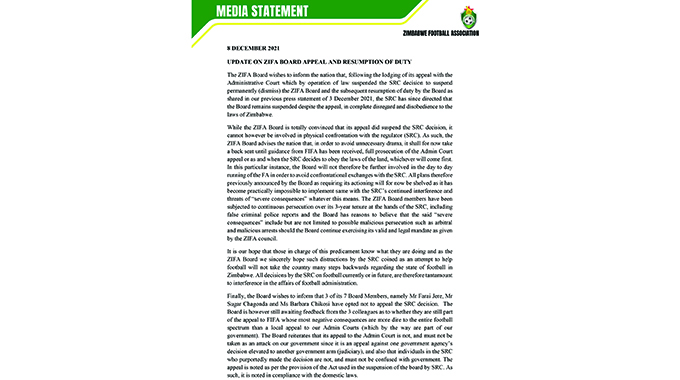Editorial Comment: Bus passenger vaccination will help curb infection

Public transport must be a major spreader of Covid-19 now that so much work has been done by many employers, including the Public Service Commission, to have very high vaccination levels at workplaces, the mass vaccination of vendors in major markets, and the rules now being enforced to allow only the vaccinated into bars, restaurants and nightclubs.
In theory bus crews are supposed to enforce masking and sanitising for all passengers, but this is not really enforced in the Zupco franchised fleet, is exceptional in the unregistered kombis and is totally and possibly deliberately ignored among the mushikashika.
The Cabinet decided this week to plug the loophole by agreeing that full vaccination will be required as soon as possible. This was backed by a second decision to introduce vaccination stations at all terminuses so passengers have no excuses in the run up to the vaccination mandate not to get their jabs. In any case with vaccination made easy for passengers a rising percentage of passengers in each bus should be vaccinated as we move towards the mandate that all must be vaccinated, and that will help almost immediately.
But there are a number of other measures that should be included. For a start all terminuses now should be fenced with controlled access. While terminuses are generally almost free of crime, and touts are no longer the menace they once were, it would be useful to make these totally crime free and stop people sleeping in them overnight. A handful of municipal police could easily control the gates at even the largest terminuses.
Secondly when the compulsory vaccination is introduced, a lot of delays will be avoided if only the vaccinated are in the terminus for a start. While bus conductors will have to see cards for those boarding as they come into town, and people picked up at intermediate stops, the huge crowds that assemble at terminuses will have been checked out before they even line up to board. Considering the dangers that those crowds can generate, this would be an advantage. This would also ensure that the vendors selling drinks and snacks are vaccinated as well.
At the same time, Zupco needs to become larger and more inclusive so that all non-Zupco buses and kombis are eliminated by being brought under control. Many intercity bus operators, who run good services, are outside the Zupco ambit but it would be easy to include them, even without subsidies but answerable to Zupco inspectors. We could have the best of both worlds.
There are other bus companies that have shown a great deal of innovation with services from industrial areas straight to suburbs without going through city centres. This needs to be encouraged and these routes could easily be registered and the operators given protection against pirates. At the same time the health rules and vaccination rules could be enforced.
There is still a large fleet of kombis not under the Zupco banner. Yet they obviously provide a service and, to be blunt, they tend to be more eager to stop and pick up passengers at intermediate points than many franchised by Zupco. Instead of fighting them we need to figure out how to include them.
Some are unlikely to meet Zupco standards, but perhaps there could be a provisional registration, with a decent interval granted to get up to scratch. In any case they obviously must be able to meet VID safety standards, and having them with some sort of official status would make it easier to insist on this. It would also make it easier to force them to conform to public health standards.
The mushikashika still do thriving business, with intermittent enforcement and drivers who seem to know every possible side road. These do, on health grounds as well as safety grounds, need to be eliminated from the public transport network. Quite possibly a campaign among their passengers would help, stressing the dangers.
But the pirates can be largely eliminated if Zupco itself upgrades services with its own fleet and the franchised operators. Gaps between Zupco-branded buses tend to be long on many routes, especially outside peak hours, with no one knowing when the next bus will pass. And when it does it is often full and so does not stop. This is what provides the opening to the pirates.
Catching a Zupco-branded bus in a city centre is relatively easy, just going to the terminus and lining up at the stop for the desired route and boarding the buses as they come up. Crews, for many good reasons, like to wait until the bus or kombi is full before leaving and that does make it hard for those at intermediate stops. They have to hope the bus will stop to let someone off at their stop so they can take the seat, or otherwise they need to rely on the more innovative mushikashika and accept what should be unacceptable health risks.
Return trips into the city centres are not so difficult, since buses do leave the outer points of their routes before they are full as there is no space for buses to wait and crews are usually keen to get to the main terminuses to fill up. But even so the gaps can be unacceptable.
Zupco have been asked to start to reintroduce scheduled routes, and since then two batches each of 50 new buses have been commissioned and right now a larger batch of 90 new buses is being prepared for service. If a passenger knew that at 12 minutes past every hour a Zupco bus would stop at their bus stop, they would be able to make their own arrangements to be there on time and would be less tempted to risk their health and safety with a mushikashika.
Franchised kombis, especially if that fleet became all inclusive, would be able to take up much the load on more frequent scheduled services and be viable with the lower traffic outside peak hours.
Zupco has done a lot to cope with the peak hour traffic, and adding rail services on routes where there is a rail line was a smart move. But now the company has to be thinking about the periods between peaks, which does demand scheduling, and at all times be working out how to give a decent service to those who need to board at the intermediate stops between a terminus and the end point. Zupco also needs to be moving forward from the more innovative franchise holders and pirates to be looking at the circular and connecting routes.
The test of a first class public transport system is simple. It is that anyone can travel around a city on public transport and never having to walk more than 1km and never having to wait more than half an hour. This is possible. Anyone looking at the very complex rail, tube and bus maps for say London will see what is needed.








Comments